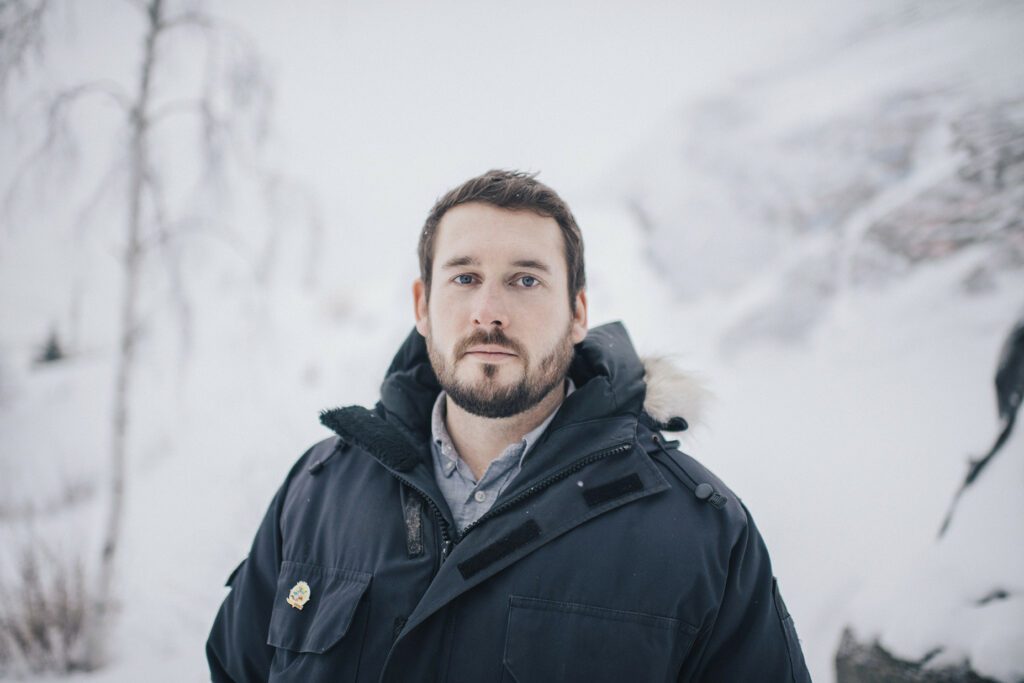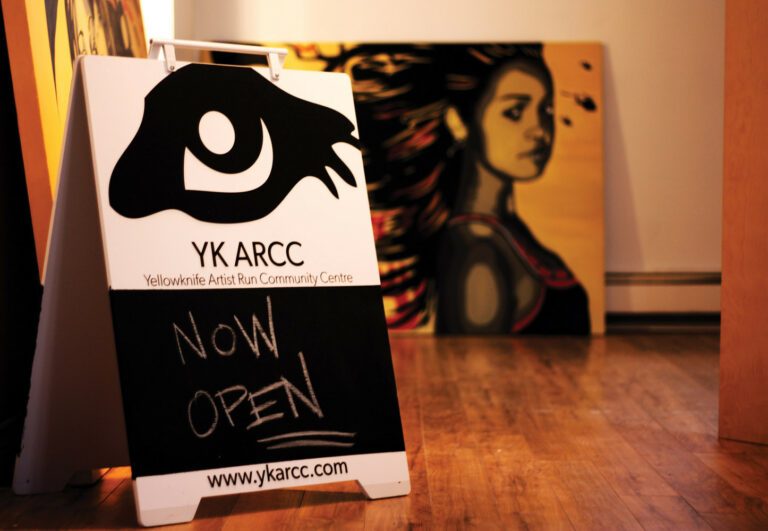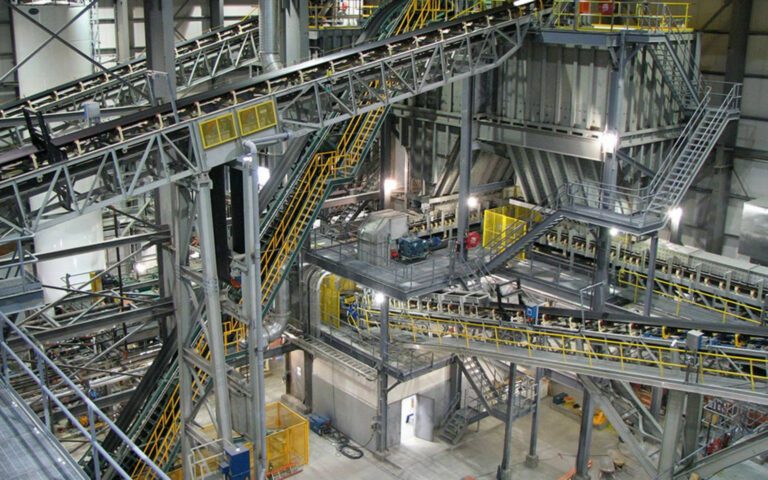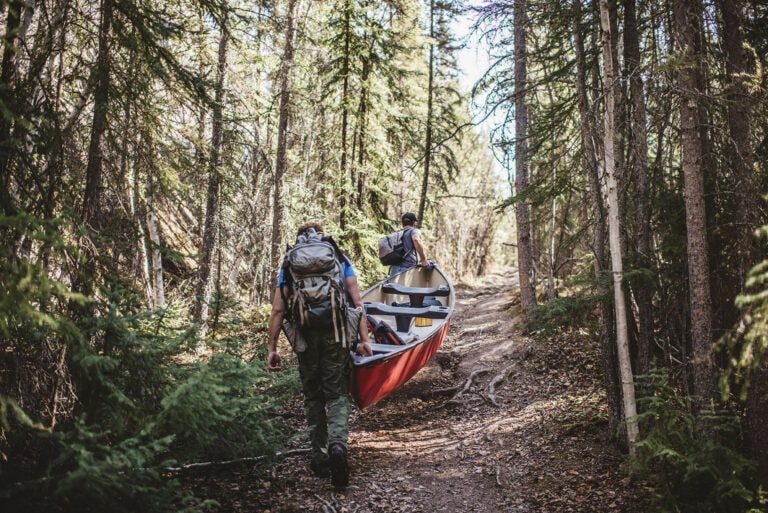For a dreamer, the potential of a northern university is right in front of us, as steady and foundational as bedrock. Millions of dollars flow into the NWT every year to conduct research in partnership with northern organizations – we’re about as dynamic and study-worthy as it gets. Historic self-government agreements are coming into place, fly-in communities and mines are figuring out ways to generate their own power, permafrost scientists are watching the cause and effects of having the entire landscape of the territory shift, Indigenous languages are being revitalized, new ways of reclaiming mines are being developed. To put it all under one roof, along with the degrees and trades training that could elevate NWT students to make careers out of such innovation, could make knowledge the territories’ new economic driver. With its plans to gradually turn Aurora College into a polytechnic university, the GNWT hopes to do just this.
How we get from here to there is still to be determined. We need to find the right path soon and then hurry down it, and our communities will need to put aside some old, old grievances to make it happen – primarily, as the last year has shown, the issue of where we should put the thing.
The Dream
Newly re-elected City Councillor Julian Morse is one such dreamer. He has been council’s most vocal advocate for a Yellowknife-based university since his first run for office. “I was sitting in an interview with a reporter and they asked me something like, well, ‘What do you think is the big missing piece in Yellowknife?’ And I just immediately said, ‘A university.’” Morse was able to get council to spend $50,000 this year to look at economic benefits from a university and what the municipality could do to support it.
“There’s already people coming here,” says Morse. “The point is that we don’t have the school to house them. If it was packaged right and if the university was done right, it could offer unique programming that couldn’t be done elsewhere.”
Imagine courses in ecotourism partnering with aurora tourism outfitters to offer scientific seminars on aurora; or giving the cultural context of the northern lights from an elder employed by the university. These are ideas from Dr. Stephanie Irlbacher-Fox, an Inuvik-raised academic with a PhD from Cambridge University. “You can go to Greece and Italy and you’ll do the classical-whatever tour and they have Cambridge experts in Roman history and in Greek history and philosophy and they lead the tour,” says Irlbacher-Fox. “I think that’s a perfect example of what the aurora tourism industry could look like.”
The university, situated in a territory where thawing permafrost is changing a landscape that’s been frozen since the Laurentide Ice Sheet retreated, could also capitalize on climate change research, which “has become a huge academic industry,” says Irlbacher-Fox. Similarly, there’s potential for partnerships with the new hospital, the Inuvik Satellite Station Facility, or the Northern Farm Training Institute in Hay River.
As well, she says core programs Aurora College has been delivering such as social work, nursing and teacher education could be improved upon and stabilized by university accreditation and resources. “When it comes to things like nursing, national standards are set. The curriculum is set. You just need qualified teachers.”
To say that there’s a challenge associated with doing something is not the same as saying it can’t be done.
Really, one needs only to look at the news to see academic opportunities. The Gwich’in Tribal Council donated a priceless trove of recorded oral history to the NWT Archives in Yellowknife, a place already full of cultural and historical riches, to be catalogued and stored. Deline is two years into its community self-government journey, and the Tlicho region nearly 15 years – with many other Indigenous peoples working towards similar agreements. These are ground-breaking and unique in Canada, as is the developing governance structure of the NWT. According to Irlbacher-Fox, the academic world is willing to put its money into the North, but it has few places to put it.
She’s worked for Indigenous governments in the NWT on self-government, land claims and political development for the past two decades. In addition to several roles in academia, Irlbacher-Fox is based in Yellowknife as scientific director for Hotii ts’eeda, a research support centre for researchers, organizations and community members. “I do academic research,” she says, “but because there’s no university, I had to figure out how do I get, for example, research funding from national funding bodies without being a prof at a university?”
The prospect of a Northern university has been debated across the three territories for years. Some, such as academic and CBC Eye on the Arctic contributor Heather Exner-Pirot, have said a university wouldn’t be the best use of government cash. With a low population base and high costs of moving here compared to moving to a southern locale, Exner-Pirot said a university would have trouble attracting a student body. And with limited funds to draw on, Exner-Pirot questioned how a territorial government could afford to start a university.
Morse has seen the arguments and is unfazed. “To say that there’s a challenge associated with doing something is not the same as saying it can’t be done.” Irlbacher-Fox agrees. “I can see where [those arguments] would be coming from but I think that that sort of approach could be used to justify that we shouldn’t really have anything here, right? Probably, based on our population, we shouldn’t have an airport; we probably shouldn’t have a hospital.”
Irlbacher-Fox is adjunct professor in the Department of Native Studies at the University of Alberta and at Carleton University’s School of Public Policy and Administration. “What that allowed me to do was apply for research funding. Through the course of that, I learned a lot about if we had a university here, what the advantages would be in terms of being able to do research with communities and the greater level of control that we would have.” She says it would also funnel a lot more money into the territory. “I have held grants in excess of $10 million over the past 10 years.” Currently, she holds two grants, one of which is a $2.5-million research grant that’s created jobs for two people locally and will provide funding to 60 graduate students across Canada, she says.
“I’ve always occupied this sort of odd space where I don’t quite fit anywhere, and that made me realize that there’s a lot of money that is going untapped because we don’t have a university or a polytechnic or something, or even a college that is, you know, functioning really well.”
Which leads us to the elephant in the room: Aurora College.
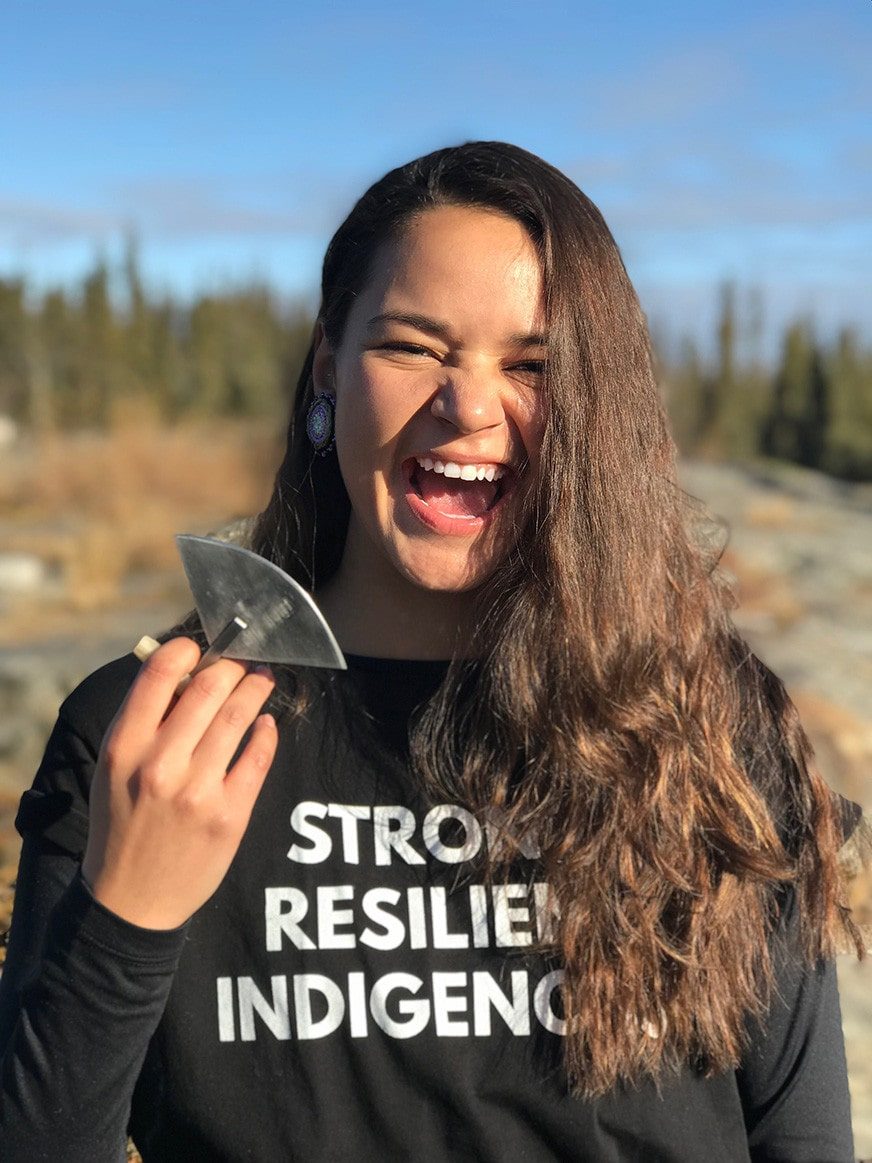
Kyla Sedaya Lesage is a Vuntut Gwitch’in student who attended Dechinta’s fall program.
Photo courtesy of Dechinta Centre for Research and Learning.
A college in shambles
The GNWT made public a foundational review on Aurora College in the spring that basically advocated for overhauling the whole thing from the ground up and making it into a polytechnic university.
Aurora College, headquartered in Fort Smith with 22 community learning centres across the territory and the Aurora Research Institute in Inuvik, is the territory’s main post-secondary institute. It grew from a vocational training centre in Fort Smith to Thebacha College in 1981, then became Arctic College in 1984 with campuses in Fort Smith and Iqaluit. The GNWT established the college as an arms-length corporate entity with the responsibility to deliver adult and post-secondary education, and had it absorb the web of community learning centres across the North. The institution split into Aurora College in the West and Nunavut Arctic College in the East in 1995, ahead of the creation of Nunavut.
Somewhere along the line, Aurora College’s momentum evaporated. The foundational review concluded that the institution, to put it mildly, was not equipped in its leadership, programming or operational capacity to keep pace with advances in education. It’s not all the college’s fault. Ostensibly arms-length, college staff told researchers and media that roles and responsibilities were muddied between the institution and the Department of Education, Culture and Employment, and communications from the department were indirect and inefficient. But in attracting students and delivering graduates, the college has been a costly failure. Between 2015-16 and 2016-17, it cost around $200,000 per graduate to deliver Aurora College’s social work diploma program and produce seven graduates total; around $100,000 per graduate to deliver its bachelor of education program, producing 21 graduates; and around $150,000 per graduate to deliver its bachelor of nursing, producing 22 graduates. The review states that the average cost per graduate for nursing degrees at post-secondary institutes across Canada is $25,000 to $30,000.
The social work program was nearly cancelled this year, and a GNWT-commissioned report on how it should change was nearly buried until Yellowknife Centre MLA Julie Green dug it up and released it. The report is eye-opening. While the teaching, cultural context and societal niche this program aimed to fill proved its importance, students complain that they’d prefer to work towards a bachelor’s degree, increasingly the minimum standard for social work jobs in Canada. (The NWT has unique legislation allowing diploma-holders to work as social workers, though even the GNWT requires BSWs for the better jobs.) Half of the program’s participants are Indigenous, which bodes well for creating a homegrown and culturally-competent social work labour force in the NWT, but the program is failing to keep students engaged and on board. The infrastructure where the program is delivered in the NWT is barely sufficient to teach the students it does retain, according to the report.
The North can be full of naysaying, Yellowknife in particular.
Another example given in the report was a 2014 review of the college’s business administration program, which didn’t have many partnerships with, or connections to, actual employers or business sectors, provided only a basic exposure to various concepts and didn’t have a clear direction.
The trades programs, once bread and butter for the institution, have declined in enrollment by more than half since 2012-13, with students saying they didn’t want to move to Fort Smith when their employers were in Yellowknife, housing in Fort Smith wasn’t suitable and the programs were often offered at busy times for their industries. Students instead took territorial Student Financial Assistance grants and loans and went south for training, as they would have had to move anyways and considered the training out of territory to be of better quality.
But there are great staff at these schools doing their best, and great students taking advantage of the opportunities offered to get their education. Fort Smith hosts the college’s headquarters and is proud of its role as the centre of post-secondary education in the territory. But one of the report’s central recommendations is to relocate headquarters to Yellowknife so the polytechnic’s administrators can better work with government and make partnerships with industry, much of which is based in the capital. Since the report came out, Fort Smith residents have rallied against this suggestion. At a public meeting in June, former Thebacha MLA and finance minister Michael Miltenberger reminded the GNWT that a promise had been made 50 years ago to keep Fort Smith as the capital of post-secondary education while it made rival community Yellowknife the territory’s capital city. “We’re saying there was an agreement to us, like a treaty, like a land claim, that was a commitment,” CBC North reported Miltenberger saying.
Fort Smith Mayor Lynn Napier-Buckley, who has called the report “demoralizing” and “arrogant,” was re-elected this fall. While there were plenty of municipal projects on her platform, there’s no doubt her leadership against the Aurora College move was part of the reason she was re-elected. Residents, and Napier-Buckley herself, have been clear they are behind a revamp and revitalization of the institute, but they don’t want to lose what’s both a source of pride and a huge economic driver for the small town. As much as Education, Culture and Employment Minister Caroline Cochrane tried to soothe these concerns, saying the GNWT would not let Fort Smith be left behind and lose this sector in the transition, a suspicion remains, with both Napier-Buckley and Inuvik town councillor Clarence Wood telling CBC that they find the centralization of services in Yellowknife troubling.
When the GNWT finally tabled its response to the foundational review this fall, it recommended a full-throttle “Go!” for many of the report’s recommendations. Within the next year the GNWT aims to hire an assistant deputy minister to helm the transition. It was a confident step forward except for one aspect: the tepid dance-around of the institution’s location. The GNWT says it will continue a “three-campus model” with the new institution split ostensibly evenly between Fort Smith, Inuvik and Yellowknife. Speaking before the GNWT’s response came out, Irlbacher-Fox said she could see a Yellowknife-based university being a benefit territory-wide, if it’s done right. “If it’s truly going to be an NWT institution with a headquarters in Yellowknife – or with a significant presence in Yellowknife – in order to make sure that it’s something that’s useful, Indigenous governments need to be engaged on what this institution is going to look like,” she said. Beyond it being the hub of government and major industrial activity, “Yellowknife is sort of the place where everyone in the NWT gathers and everyone passes through it. Everyone has connections to here somehow.” But it’s the path to creating the new institute, not necessarily its placement, that will determine how it benefits the communities. “[It must] have Indigenous governments involved in the design and the implementation and helping to figure out how we ensure that we create an institution that can achieve excellence, that can serve our communities and that can provide an economic boost in every region of the end of each year. And I think that’s really possible.”
Finding the path
Morse has a diploma in environment and natural resources technology from Aurora College, class of 2011. He looks back fondly at his time in Fort Smith – “It was great, I got a lot out of it” – but is pragmatic more than nostalgic. “It would be best if we took the existing institution and revitalized it. If we were to try and build something alongside Aurora College, it’s going to create potential redundancies.” And not just programming – the GNWT, perpetually stretching its dollars, is the primary funding source of Aurora College providing close to $32.4 million in the current budget. “If the institution was brought to be more arms-length from the government and started identifying its own funding sources, it would be cheaper,” says Morse. “A point that I’ve consistently made when talking about this is that Yukon College is bigger, more successful, employs more people and has more students than Aurora college and yet it costs the Yukon Government significantly less money.”
Yukon College is singing a different tune than our Aurora. In a 2015 exit survey of students, 97 percent returning to class in the fall of that year said the college was doing a good job. Three-quarters said they were gainfully employed, of which two thirds were working in fields related to their studies. Building on that success, by 2021, Yukon College will become Yukon University.
As it transitions to Yukon University, the institution has announced its first focuses: climate change; Indigenous self-determination and governance; and sustainable resource development, technology and innovation. While it may look like the Yukon is eating our lunch, it’s not. We didn’t make any lunch. It just made the lunch we would make if we got up off the couch.
The North can be full of naysaying, Yellowknife in particular. The prospect of using geothermal heat, repurposing the remnants of Con Mine, hosting the 2023 Canada Winter Games, all fizzled under city-wide skepticism.
But the North is also a place for dreamers. Look at Dechinta Centre for Research and Learning, the territory’s “bush university.” Despite being cold-shouldered for core funding by the GNWT, the private institution has been offering university-accredited on-the-land programming through partnerships with institutions such as the University of Alberta. With just $1.5 million from the GNWT, as well close to $1.3 million from tuition, the feds and other sources, Dechinta has made itself an internationally acclaimed institution. This year it was inducted into the University of the Arctic, an international cooperative comprised of universities, colleges and research institutes focussed on education and research in the North. Imagine what a full-scale university could do.
The GNWT has more-or-less committed to following the recommended timeline for a gradual transition from Aurora College to polytechnic university by 2024. The issue of moving its headquarters has been put to bed for now – no doubt to be awakened by the next legislative assembly. It’s important that the argument for a Yellowknife headquarters continue to be made. If trades programs will be better utilized in Yellowknife, they should be there. If administration could gain more financing and forge more partnerships by being in the capital, they should be there. Fort Smith, Inuvik and the rest of the NWT need to see benefits for the university to be a success – but the university also needs to be a success for those communities to see real, growing benefits. We shouldn’t refuse to take bold action because not everyone agrees with it. One of the report’s main criticisms of Aurora College was that it was rendered ineffective from its attempts to be everything to everyone.
Maybe we should have faith, once in a while, that our government can make something good; that what’s good for Yellowknife can benefit the territory and a rising tide here can lift all boats. Rather than concentrating on doom and gloom possibilities, let’s just get to work and at least try to do it right.

